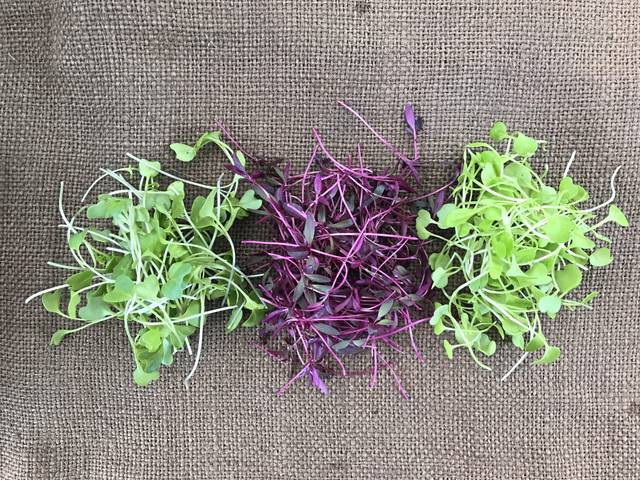Grow your own microgreens
Growing microgreens is a great way to get some homegrown veggies into your diet during the winter months.
Microgreens are the young shoots of various plants, harvested soon after the seedling develops its first set of leaves. Microgreens are somewhere in between the “sprout” stage and the “baby greens” stage of plant growth. They’re ready to eat just two to three weeks after the seed was sown. They have a crisp texture and fresh flavor.
There are many different plants that can be grown as microgreens. You can grow lettuce, kale, chard, mizuna, mustard greens, cabbage, beets and broccoli in this manner. All are delicious when harvested young. Radish, peas, amaranth and kohlrabi also make great microgreens.
If you want a greater diversity of flavor, you can even grow herbs like cilantro, dill, fennel, arugula, basil and chervil as microgreens. And, sunflowers are another surprisingly delicious choice.
Microgreens are reported to have more nutrients than a mature plant of the same species. Their crisp texture and fresh flavor make microgreens a delicious garnish, salad topping or sandwich condiment.
Regardless of which microgreens you decide on, the growing technique is the same.
Here’s a simple way to grow your very own crop of microgreens.
Step 1: Gather your materials
To start growing microgreens, you’ll need the following items:
• Plastic nursery flat (either new or sanitized with a 10% bleach solution)
• High-quality sterile potting mix
• Seeds
• A fluorescent shop light hung from chains, equipped with regular fluorescent bulbs or grow light tubes
• A sheet of plastic wrap large enough to cover the nursery flat
Step 2: Plant the seeds
To plant your microgreens, begin by filling the nursery tray with potting mix about half way. Moisten the potting mix with a little water and tamp the tray on a table to remove any air pockets. Spread the seeds thickly across the top of the potting mix. Seeds should be roughly a quarter of an inch apart. Cover the seeds with a thin layer of potting soil and water them in. Label each variety with a waterproof plant tag and cover the flat with the sheet of plastic to keep the humidity high.
Step 3: Set the lights
Put the seeded flat under the fluorescent shop light. Lower the light so the bulbs are only 2 to 3 inches above the top of the flat. The lights should be on for 16 to 18 hours per day. Setting them on a timer is a great idea.
Step 4: Remove the plastic
As soon as the seeds begin to germinate, remove the plastic sheet to prevent fungal issues from taking hold.
Step 5: Water
Water the seedlings as necessary with a gentle shower. Do not allow the flat to dry out.
Step 6: Harvest
Your microgreens are ready to harvest when they’re anywhere from one to three weeks old, depending on the variety. Soon after they develop their first set of true leaves, use a sharp scissors to cut the seedlings off just above the soil surface.
Step 7: Wash and enjoy
Before eating your microgreens, run them under a gentle stream of water to wash off any dust or potting mix, and dry them by laying them out on paper towels.
With microgreens, you can enjoy a taste of spring all winter long.
Horticulturist Jessica Walliser is the author of several gardening books, including "Attracting Beneficial Bugs to Your Garden," "Good Bug, Bad Bug," and her newest title, "Container Gardening Complete." Her website is jessicawalliser.com. Send your gardening or landscaping questions to tribliving@tribweb.com or The Good Earth, 622 Cabin Hill Drive, Greensburg, PA 15601.
Remove the ads from your TribLIVE reading experience but still support the journalists who create the content with TribLIVE Ad-Free.

